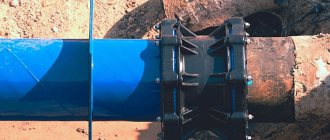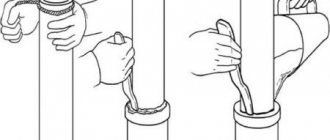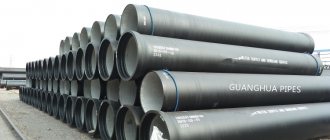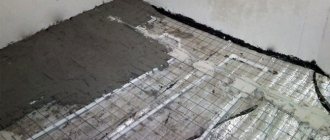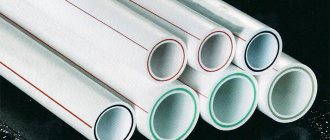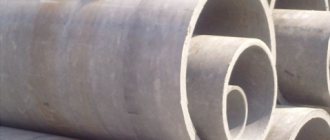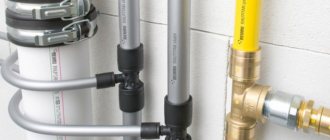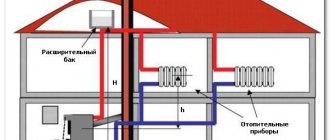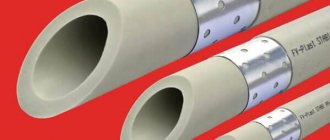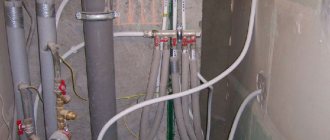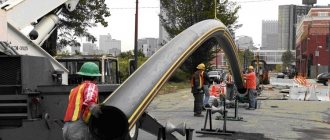Service life of cast iron sewer pipes: service life of plastic elements
Some users are interested in what is the service life of cast iron sewer pipes. This is not an idle question, since most risers and basement pipelines in apartment buildings are assembled from these elements. Modern systems are usually assembled from plastic pipes, which are convenient and easy to replace.
However, existing cast iron channels are still quite capable of doing their job. During the next repair, you constantly have to decide whether it’s time to change the old elements and how many years they can serve. They still look strong, no defects are noticeable, what should I do? Let's figure out together what the features of these sewage components are.
Reasons for the current relevance of cast iron pipes
Nowadays, when polymer materials occupy an increasing share of the market, cast iron pipes may simply seem like an outdated solution to many. Nevertheless, they continue to be used in water and heat supply systems, oil pipelines, fire extinguishing systems and other industrial facilities. This happens because the service life of cast iron sewer pipes is very long, they have some important characteristics, plus they have been tested in practice for years.
The main technical characteristics include:
- oxidation resistance, it is higher than that of steel;
- have a low coefficient of thermal expansion;
- high wear resistance;
- excellent sound insulation – the sound of running water is almost inaudible;
- enhanced strength - resistance to mechanical shocks, pressure drops - accident rate is minimal;
- the ability to work for a long time in conditions of low and high temperatures, while in the event of temperature changes the operational properties of the material are not lost;
- cast iron is an environmentally friendly material, as it does not emit toxins;
- does not ignite;
- such pipes are quite easy to lay, you can always find components for wiring the system;
- low cost of work on laying and operating cast iron pipes;
- the price is affordable for everyone.
The service life of cast iron sewer pipes in an apartment is not inferior to plastic pipes. The latter can also function in high-temperature conditions, while they cost much less, and they have less weight, that is, they are much easier to install.
Cast iron pipes also have a number of disadvantages:
- Large mass . Because of this, the process of laying pipes in difficult conditions is greatly complicated. To transport them, you need to order special vehicles.
- Docking process . It is a slow activity, which, moreover, takes a lot of energy.
- Tightness of joints . This is the weak point of cast iron pipes - in about 5-7 years they will have to be minted in a new way.
These nuances force many consumers to prefer plastic pipes.
However, in conditions where the sewerage system has special requirements for strength and acoustic parameters, or the load on it will be stronger throughout the entire time, it is better to use cast iron products. Due to their large mass and thick walls, cast iron pipes can withstand heavy loads, they are wear-resistant and durable, and they dampen sound vibrations well.
How long do sewer pipes last?
The service life of sewer pipes depends on various factors:
- working conditions;
- features of the material;
- magnitude of loads;
- the composition of wastewater that moves through this section of the system.
As a rule, sewer systems have a gravity operating principle. This means that there is no pressure inside the pipelines, the drains move under the influence of gravity. The main factors that destroy networks are:
- temperature changes;
- mechanical loads arising from soil pressure.
It is noteworthy that the service life of pipelines depends on the characteristics of the material to a lesser extent than on operating conditions. It is believed that cast iron components can last about 80 years, although in practice their service life can be much longer. For comparison, the service life of plastic sewer pipes declared by manufacturers is about 50 years. These values are conditional, since serious amendments are made by operating conditions. However, statistics confirm the correspondence of these values to the real situation.
If the system is periodically maintained, regularly cleaned and protected from external influences, the operating life of its elements increases significantly. Most problems arise due to mechanical breakdowns, deformation and other abnormal situations. If normal operating conditions are ensured, pipelines will be able to show their maximum service life.
Why cast iron components continue to be used
Almost all Soviet-built apartment buildings have a cast-iron sewer riser, the service life of which exceeded the initial service life of the building itself. Despite the long-standing commissioning, the system is in no hurry to change. Usually the internal (apartment) part of the sewer system is replaced with plastic elements, but the riser and external section are retained. This is explained by the serious advantages of cast iron parts:
- high strength, rigidity;
- ability to withstand high loads;
- Cast iron wears out significantly less than other materials under the same load.
An important quality of metal is its ability to withstand significant loads. Cast iron does not withstand sharp impacts, but it can easily withstand uniform and stable pressure. This has become the main reason for the use of metal elements in external and underground lines. Considering the long service life of cast iron sewer pipes, replacing old mains is not yet relevant. In addition, possible costs must be taken into account. Work to update the network will cost an amount comparable to the construction of a new system.
What determines the duration of work?
The service life of plastic sewer pipes depends on operating conditions. The main factor contributing to the early destruction of systems is the thermal expansion of PVC. It negatively affects the structure of the material, destroys connections and disables the line. The more uniform the thermal regime of the wastewater, the less the linear dimensions of the components change.
The service life of cast iron sewerage also depends on operating conditions, but the main danger for it is corrosion. For protection, an external coating of bitumen is used. Modern products are equipped with an outer layer of whitewashed cast iron, which shows greater resistance to corrosion. This allows you to save the canal walls from destruction. However, if the material has holes, cracks or other defects, the effectiveness of protection is sharply reduced. In this regard, plastic parts with a homogeneous structure are the leaders.
It is necessary to take into account that the service life of a cast iron sewer pipe largely depends on the quality of the assembly and the reliability of the connections. Often they replace quite strong systems that give a lot of leaks due to leaks in the connections. The assembly of metal elements requires experience and skills, since the socket must be filled with a special compound (caulked). If the work is performed by an untrained person, the system will not last long.
An important indicator is the quality of the material itself. There are many grades of cast iron, its structure varies depending on the smelting technology. High-quality metal can be distinguished by the following characteristics:
- at the fracture it is fine-grained, of uniform composition;
- there are no voids, cavities or other defects in the array. When tapped, high-quality material gives a clear and sonorous response.
When purchasing products, you should inspect them carefully. The most susceptible area to destruction is the bell. It is necessary to check for cracks or broken areas. Items with such defects should be rejected.
Factors affecting the service life of cast iron sewers
The concept of “service life of cast iron sewer pipes” implies, in particular, the total duration of operation of the system without the need for urgent or planned repairs or replacement of its individual parts. Ideally, drainage systems made of gray cast iron can last about 60-80 years. But this is only possible if you handle pipes and fittings carefully.
As for the service life of sewer pipes made of ductile iron, it is at least 100 years.
One of the main conditions for long-term and uninterrupted operation of cast iron sewerage is the presence of high-quality pipes and fittings for them. This means that the surface of the cast iron must be uniform and smooth, without frozen metal drops or sagging, without layers of slag and all kinds of growths. The diameter and length of pipes and fittings for their joining must comply with the requirements of regulatory documents - GOSTs.
How to increase the duration of use
The service life of cast iron sewer pipes can be increased if optimal operating conditions are provided for the system. First of all, the assembly of the line should be done by craftsmen with extensive experience. Most problems arise from the destruction of connections resulting from a lack of tightness. Leaks appear and soil infiltrates into the system. Over time, dense blockages arise that are difficult to clean.
All deposits on the internal walls should be removed regularly. There are various methods for flushing or mechanical cleaning of network components that allow you to restore clearance and ensure line throughput. If the service life of PVC external sewerage pipes mainly depends on changes in size and temperature expansion, then metal networks need protection from corrosion. In addition, constant monitoring of the condition of the trenches and the absence of soil subsidence under wells or pipelines is necessary. It is important to organize regular inspection of visible network elements in order to detect changes in time and make repairs.
Service life of a sewer pipe in a private house and apartment
Repair work related to the complete or partial replacement of pipes in drainage systems in private houses and apartment complexes is a rather labor-intensive process. This is due to the location of communications and the need to dismantle plumbing equipment. Therefore, when designing and constructing sewer network installations, special attention is paid to the choice of sewer pipe material. The main selection criteria are the material itself and the strength class, according to the current GOST, corresponding to preliminary technical and economic calculations based on the operating conditions of sewer pipes.
Sewage pipe system
The most common types of sewer pipes are:
- polymer pipes (polyethylene, polyvinyl chloride);
- ceramic pipes;
- cast iron
Depending on the operating conditions, each of these types of products has a certain service life.
Material of manufacture and technical characteristics
Before purchasing plastic pipes for sewer or water supply installations, you need to pay attention to the technical characteristics of the material and weigh the pros and cons.
Polypropylene pipes
Polypropylene is produced in the form of granules, from which pipes of different diameters are cast during heat treatment. PP does not chemically interact with acids and alkalis, does not emit harmful substances, therefore it can be used in cold and hot water supply systems. The material becomes soft at 145 degrees, so it can withstand hot drains up to 95 degrees without deformation.
- resistant to mechanical shocks;
- low temperatures have no effect if ethylene is added to the molecules;
- wear resistant;
- Aluminum-reinforced polypropylene deforms less when heated;
- sensitive to oxygen and ultraviolet radiation - to reduce the performance, stabilizers are added to the composition.
Depending on the filling, you can create a material with new properties:
- Glass filled. Fiberglass increases bending elasticity and increases the strength of finished products.
- Mineral-filled. The introduction of calcium carbonate increases the thermal insulation properties of PP.
- Elasticated. By adding elastomers, the frost resistance of pipes and their elasticity when bending increases.
- Low-flammability. Produced by mixing granules with antiprene. If a fire occurs, the material extinguishes on its own.
Service life of cast iron sewer pipes
Cast iron sewer systems are used in private individual construction and in the construction of apartment buildings. According to current departmental building standards, cast iron pipes, subject to optimal operating conditions, the trouble-free service life of these products ranges from 50 to 70 years. This is considered the main reason for choosing cast iron pipes when installing sewerage systems in apartment complexes.
Cast iron sewer pipes
The distinctive characteristics of such systems are:
- high wear resistance;
- strength;
- low susceptibility to corrosion.
An additional positive quality is the ability to withstand high pressure when removing blockages using the water hammer method and further washing under pressure.
Avoid shock loads during installation.
Pressure cast iron pipe GOST 9583-75
9 misconceptions and cast iron
We invite you to read a short excerpt that presents the main misconceptions regarding ductile iron pipes.
For sewage systems, pipes made of various polymer materials have recently been increasingly used, installing them on new wastewater drainage networks and replacing existing cast iron ones. However, the age of the latter is not over yet and their use not only remains relevant, but in some cases the only possible one. In terms of service life, cast iron pipes are not inferior to those made of polymers.
Service life limits for plastic sewer pipes
Current building codes and regulations governing the installation of sewerage systems provide for the possibility of using plastic pipes in the mains of drainage systems.
Types of plastic pipes
The positive qualities of this type of product made from polypropylene (PP), polyethylene (PE) and polyvinyl chloride (PVC) include the following characteristics:
- light weight;
- resistance to aggressive environments;
- immunity to corrosive processes;
- low probability of the formation of insoluble sediment on the inner surface of the pipes (exception, joints);
- ease of installation and dismantling;
- long service life of individual parts and the sewage system as a whole.
The average service life of plastic sewer pipes is 25 years. This period may vary. How long trouble-free operation will last depends on the conditions of installation and operation of the sewerage system. The positive qualities and service life of plastic sewer pipes are the main indicators when choosing a pipeline material when arranging a private house and apartments in apartment complexes.
PVC sewer and water supply
When the building materials market began to fill with plastic products, the share of the use of such pipes in the construction of pipelines increased significantly. Most often, PVC pipes are used in domestic conditions when arranging apartments and private houses. With their help, heating, sewer, and ventilation lines are laid. Therefore, potential buyers always want to know the service life of plastic systems, what it depends on, and how the service life of PVC pipes can be increased.
According to manufacturers' advertisements, sewer pipes can be successfully operated for about 50 years.
Although, not everything is so simple, since this indicator is determined by several factors:
- type of plastic;
- environmental conditions;
- pressure in the system;
- temperature of the internal environment.
PVC products are different:
- safety, lack of toxicity;
- practicality when installing the highway;
- light weight;
- long service life without clogging;
- complete neutrality to corrosion and aggressive environments;
- resistance to living microorganisms.
PVC products are often used for the installation of cold and hot water supply lines, since they are able to withstand water temperatures within +90°C. A water supply system made from PVC pipes will last much longer than a sewer system. The service life of such PVC pipes will be approximately 50 years. Some experts even call the figure 100 years for the operation of PVC water pipelines.
How long does a sewer system last and when to replace old pipes?
Clients often come to us with questions about when it is necessary to replace pipes in an apartment's sewer system, and for what useful life is it generally designed? Replacing sewer pipes on one side will give you confidence in its reliability. On the other hand, I would not like to carry it out when the resource of the old pipes has not been completely exhausted.
